LIFE SCIENCE (NGSS)
Ecosystems: Interactions, Energy, and Dynamics
Students who demonstrate understanding can:
Use mathematical representations to support and revise explanations based on evidence about factors affecting biodiversity and populations in ecosystems of different scales.
EARTH AND SPACE SCIENCE (NGSS)
Earth’s Systems
Students who demonstrate understanding can:
Analyze geoscience data to make the claim that one change to Earth’s surface can create feedbacks that cause changes to other Earth’s systems.
Use a model to describe how variations in the flow of energy into and out of Earth’s systems result in changes in climate.
Earth and Human Activity
Students who demonstrate understanding can:
Construct an explanation based on evidence for how the availability of natural resources, occurrence of natural hazards, and changes in climate have influenced human activity.
Evaluate competing design solutions for developing, managing, and utilizing energy and mineral resources based on cost-benefit ratios.
Create a computational simulation to illustrate the relationships among management of natural resources, the sustainability of human populations, and biodiversity.
Evaluate or refine a technological solution that reduces impacts of human activities on natural systems.
Use a computational representation to illustrate the relationships among Earth systems and how those relationships are being modified due to human activity.
LIFE SCIENCE (NGSS)
Ecosystems: Interactions, Energy, and Dynamics
Students who demonstrate understanding can:
Use mathematical representations to support and revise explanations based on evidence about factors affecting biodiversity and populations in ecosystems of different scales.
EARTH AND SPACE SCIENCE (NGSS)
Earth’s Systems
Students who demonstrate understanding can:
Analyze geoscience data to make the claim that one change to Earth’s surface can create feedbacks that cause changes to other Earth’s systems.
Use a model to describe how variations in the flow of energy into and out of Earth’s systems result in changes in climate.
Earth and Human Activity
Students who demonstrate understanding can:
Construct an explanation based on evidence for how the availability of natural resources, occurrence of natural hazards, and changes in climate have influenced human activity.
Evaluate competing design solutions for developing, managing, and utilizing energy and mineral resources based on cost-benefit ratios.
Create a computational simulation to illustrate the relationships among management of natural resources, the sustainability of human populations, and biodiversity.
Evaluate or refine a technological solution that reduces impacts of human activities on natural systems.
Use a computational representation to illustrate the relationships among Earth systems and how those relationships are being modified due to human activity.
LIFE SCIENCE (NGSS)
Ecosystems: Interactions, Energy, and Dynamics
Students who demonstrate understanding can:
Use mathematical representations to support and revise explanations based on evidence about factors affecting biodiversity and populations in ecosystems of different scales.
EARTH AND SPACE SCIENCE (NGSS)
Earth’s Systems
Students who demonstrate understanding can:
Analyze geoscience data to make the claim that one change to Earth’s surface can create feedbacks that cause changes to other Earth’s systems.
Use a model to describe how variations in the flow of energy into and out of Earth’s systems result in changes in climate.
Earth and Human Activity
Students who demonstrate understanding can:
Construct an explanation based on evidence for how the availability of natural resources, occurrence of natural hazards, and changes in climate have influenced human activity.
Evaluate competing design solutions for developing, managing, and utilizing energy and mineral resources based on cost-benefit ratios.
Create a computational simulation to illustrate the relationships among management of natural resources, the sustainability of human populations, and biodiversity.
Evaluate or refine a technological solution that reduces impacts of human activities on natural systems.
Use a computational representation to illustrate the relationships among Earth systems and how those relationships are being modified due to human activity.
LIFE SCIENCE (NGSS)
Ecosystems: Interactions, Energy, and Dynamics
Students who demonstrate understanding can:
Use mathematical representations to support and revise explanations based on evidence about factors affecting biodiversity and populations in ecosystems of different scales.
EARTH AND SPACE SCIENCE (NGSS)
Earth’s Systems
Students who demonstrate understanding can:
Analyze geoscience data to make the claim that one change to Earth’s surface can create feedbacks that cause changes to other Earth’s systems.
Use a model to describe how variations in the flow of energy into and out of Earth’s systems result in changes in climate.
Earth and Human Activity
Students who demonstrate understanding can:
Construct an explanation based on evidence for how the availability of natural resources, occurrence of natural hazards, and changes in climate have influenced human activity.
Evaluate competing design solutions for developing, managing, and utilizing energy and mineral resources based on cost-benefit ratios.
Create a computational simulation to illustrate the relationships among management of natural resources, the sustainability of human populations, and biodiversity.
Evaluate or refine a technological solution that reduces impacts of human activities on natural systems.
Use a computational representation to illustrate the relationships among Earth systems and how those relationships are being modified due to human activity.
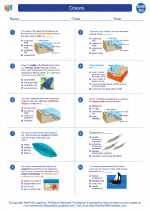
 Worksheet/Answer key
Worksheet/Answer key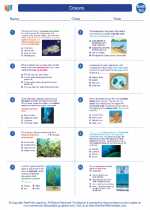
 Worksheet/Answer key
Worksheet/Answer key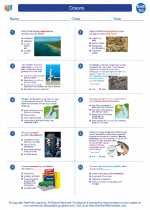
 Worksheet/Answer key
Worksheet/Answer key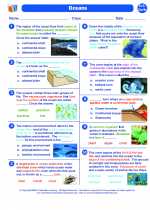
 Vocabulary/Answer key
Vocabulary/Answer key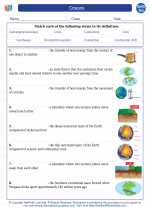
 Vocabulary/Answer key
Vocabulary/Answer key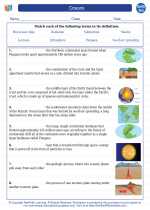
 Vocabulary/Answer key
Vocabulary/Answer key
